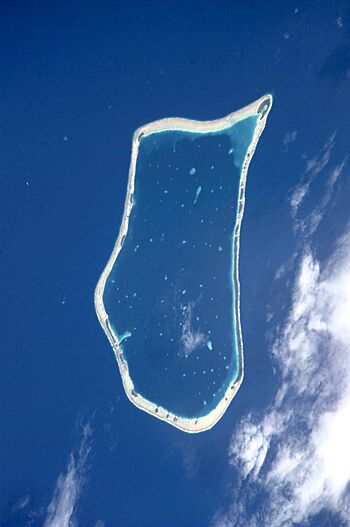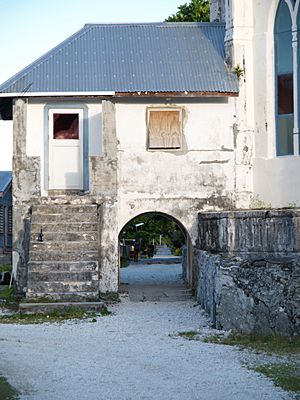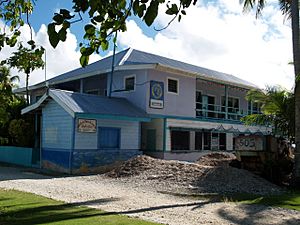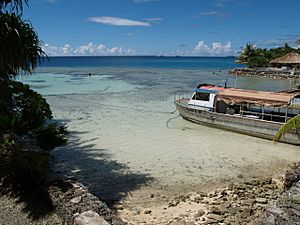Nukunonu facts for kids

Satellite image of Nukunonu
|
|
| Lua error in Module:Location_map at line 420: attempt to index field 'wikibase' (a nil value). | |
| Geography | |
|---|---|
| Archipelago | Tokelau |
| Total islands | 30 |
| Area | 5.5 km2 (2.1 sq mi) |
| Administration | |
| Dependent territory | Tokelau |
| Largest settlement | Nokunonu Village |
| Faipule (leader) | Alapati Tavite |
| Pulenuku (mayor) | Petelo Patelesio |
| Demographics | |
| Population | 531 |
| Languages | Tokelauan, English |
Nukunonu, once called Duke of Clarence Island, is the biggest atoll in Tokelau. Tokelau is a group of islands that is a dependency of New Zealand. It is located in the southern Pacific Ocean.
Nukunonu is made up of 30 small islets that surround a large central lagoon. The land area is about 5.5 square kilometers (2.1 square miles). The lagoon itself covers about 109 square kilometers (42 square miles). Only one islet, Motuhaga, has people living on it. About 531 people live on Nukunonu.
Contents
History of Nukunonu Atoll
The first European ship to find Nukunonu was the Royal Navy ship HMS Pandora in 1791. Its captain, Edward Edwards, named it Duke of Clarence Island. This was to honor Prince William, Duke of Clarence. He later became King William IV of the United Kingdom. At that time, the Pandora was looking for sailors who had rebelled from another ship, HMS Bounty.
In the early 1800s, missionaries from Samoa helped the people of Nukunonu become Catholic.
Later, in 1859, a company from the U.S. called the U.S. Guano Company claimed Duke of Clarence Island. They did this under a law called the U.S. Guano Islands Act. The U.S. government supported this claim in 1860. However, the company did not use many of these islands.
In 1889, Great Britain claimed Nukunonu and other islands as part of the Union Islands. These islands were later added to the Gilbert and Ellice Islands colony in 1916. Then, in 1925, they became part of New Zealand's territory.
In 1979, the U.S. officially gave up its claim on Nukunonu and other Tokelauan islands. This was part of an agreement called the Treaty of Tokehega. This treaty also set up a maritime boundary (a sea border) between Tokelau and American Samoa.
Life on Nukunonu
The main village on the atoll is on Nukunonu Island. It is located at the southwest edge of the lagoon. A concrete bridge connects the two parts of the village.
The people living on the island get their food from coconuts, pandanus plants, and sea creatures. Fresh water is hard to find. New houses are built with special concrete tanks at their bases. These tanks collect rainwater from the roofs. Getting supplies by ship can be difficult because there isn't a good place for ships to anchor. You can now see satellite TV dishes on some houses in the village.
Tokelau has one hotel, the Luana Liki Hotel, and one resort, Falefa Resort. Both are on Nukunonu. Not many tourists visit Tokelau, and tourism is not a big part of the economy. Some Tokelauans prefer to keep their country mostly untouched by the outside world. However, visitors are always welcomed with traditional Polynesian kindness. The Luana Liki Hotel mostly hosts official visitors, like the Prime Minister of New Zealand.
There is one main shop in Nukunonu. It sells a small variety of products. Sometimes, the shop runs out of goods because shipping schedules can be unpredictable.
Local decisions are made by a group called the Taupulega, or Council of Elders. This council includes the heads of family groups and two elected members. In 2006, 426 people lived on Nukunonu. More than 95% of them were Catholic. The most recent count in 2019 showed the population was 531 people.
Nukunonu's Environment
Important Bird Area
About 60 hectares (148 acres) on the eastern side of the atoll is a special place for birds. It's called an Important Bird Area (IBA) by BirdLife International. This area is important because many birds come here to build their nests and raise their young.
In 2011, it was estimated that about 20,000 pairs of brown and black noddies and common white terns were breeding here.
Economy and Resources
Coconuts (Cocos nucifera) are a very important food source on Nukunonu. However, a type of rat called the Black Rat (Rattus rattus) arrived with European explorers. These rats can destroy up to half of the coconut crop. The native Polynesian Rat (R. exulans) can cause similar damage if the Black Rat is not around. Controlling these rats and studying ways to stop them is very important for the island's food supply.
Islands of Nukunonu
- Avakaukilikili
- Matalapa
- Niualemu
- Hini Ailani
- Te Palaoa
- Apia
- Haumagalu
- Niututahi
- Lalohumu
- Olomoana
- Tuigaika
- Tima
- Vaivaimai
- Te Nonu
- Patiku
- Tuatiga
- Tagamako
- Hilakehe
- Na Taulaga
- Punalei
- Motu Fala
- Motu Akea
- Fulumahaga
- Na Hapiti
- Fatigauhu
- Te Afua o lafu
- Te Puka i Mua
- Motuhaga
- Te Kamu
- Fakanava Tau Loto
- Vini
- Te Puka i Muli
- Te Fakanava
See also
 In Spanish: Nukunonu para niños
In Spanish: Nukunonu para niños




